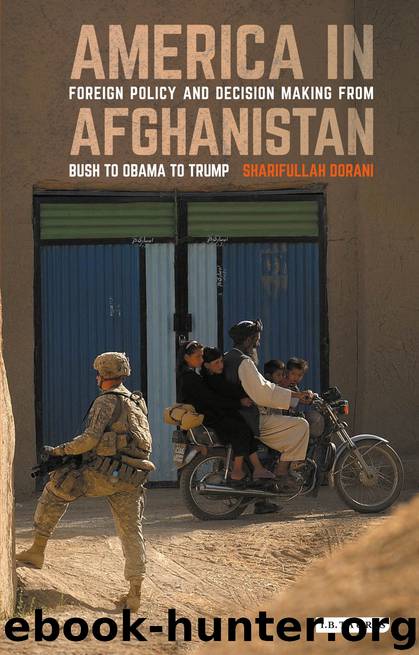America in Afghanistan by Sharifullah Dorani;

Author:Sharifullah Dorani;
Language: eng
Format: epub
ISBN: 9781786725820
Publisher: Bloomsbury UK
CHAPTER 10
THE SURGE DECISION AT THE EVALUATION PHASE AND OBAMA'S FORMULATION OF THE WITHDRAWAL DECISION, JUNE 2011
Due to the public nature of the Af-Pak review in 2009 and the overwhelming interest in the Afghanistan War and its political implications for the 2012 presidential election, all those who had been involved in the decision to surge in 2009, especially the Vice-President Joe Biden and US Commander in Afghanistan David Petraeus camps, awaited the decision of 2011 with bated breath. Most of the actors – policy makers, members of Congress or pundits from the media/press, academia and think-tanks, most of whom were the same faces as those from 2009 – remained, intentionally or unintentionally, in one of the two camps in 2011 and thus their assessments (and policy opinions) of the Af-Pak strategy remained as divided as they had been in 2009. The actors once again made attempts through speeches, publications and testimonies, especially to the Senate Committee on Foreign Relations, to influence the decision to draw down by trying to influence the public debate in the way they believed it to be right for US national security interests.
Before examining their evaluative output (and policy suggestions), however, it is important to shed light on some domestic (and international) factors, including US economic conditions.
President Barack Obama had not managed to show improvement in the American economy, forcing 70 per cent of Americans in numerous polls to disapprove of Obama's handling of the economy and to think that the country was on the wrong track. The high disapproval rating was not surprising, because, ever since Obama became president, the unemployment rate had climbed from 7.6 to 9 per cent, the national debt from $10.6 to $14.6 trillion, the budget deficit to $1,580 billion for 2011–12, US citizens without health insurance to 49.9 million, Americans living below the official poverty line to 46.2 million, or one in six, and mortgages in negative equity to an all-time high. Approximately 60 per cent of participants believed in a June 2011 Pew poll that the Iraq and Afghanistan wars were the leading cause of the United States' (US) indebtedness.1
Human costs equally concerned Americans. The American combat fatalities rose from 155 in 2008 to 317 in 2009, and 499 in 2010. 499 US soldiers represented an upsurge of 57 per cent over 2009. Secretary of Defense Robert Gates had to plead with Congress to be patient over the death tolls (and the economic costs). While the 9/11 attacks killed 2,976 Americans, US military had lost 6,234 troops in Iraq and Afghanistan by 2011. Because of the repetitive combat deployments to war zones in Afghanistan and Iraq in the past decade, the ground forces were nearly ‘broken’. The military families were under enormous stress and consequently ‘junior and mid-level officers [were] leaving the force in large numbers’.2
Due to the increasing financial and human costs, by summer 2011, opinion polls showed that the majority of Americans did not believe the Afghanistan War was worth fighting. For example, only 21 per cent
Download
This site does not store any files on its server. We only index and link to content provided by other sites. Please contact the content providers to delete copyright contents if any and email us, we'll remove relevant links or contents immediately.
| Africa | Americas |
| Arctic & Antarctica | Asia |
| Australia & Oceania | Europe |
| Middle East | Russia |
| United States | World |
| Ancient Civilizations | Military |
| Historical Study & Educational Resources |
Empire of the Sikhs by Patwant Singh(22763)
The Wind in My Hair by Masih Alinejad(4839)
The Templars by Dan Jones(4557)
Rise and Kill First by Ronen Bergman(4544)
The Rape of Nanking by Iris Chang(4022)
12 Strong by Doug Stanton(3419)
Blood and Sand by Alex Von Tunzelmann(3055)
The History of Jihad: From Muhammad to ISIS by Spencer Robert(2504)
Babylon's Ark by Lawrence Anthony(2427)
The Turkish Psychedelic Explosion by Daniel Spicer(2245)
No Room for Small Dreams by Shimon Peres(2235)
Gideon's Spies: The Secret History of the Mossad by Gordon Thomas(2231)
Inside the Middle East by Avi Melamed(2230)
Arabs by Eugene Rogan(2193)
The First Muslim The Story of Muhammad by Lesley Hazleton(2153)
Bus on Jaffa Road by Mike Kelly(2035)
Come, Tell Me How You Live by Mallowan Agatha Christie(2024)
Kabul 1841-42: Battle Story by Edmund Yorke(1921)
1453 by Roger Crowley(1879)
